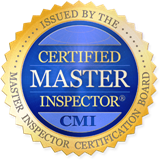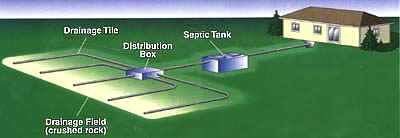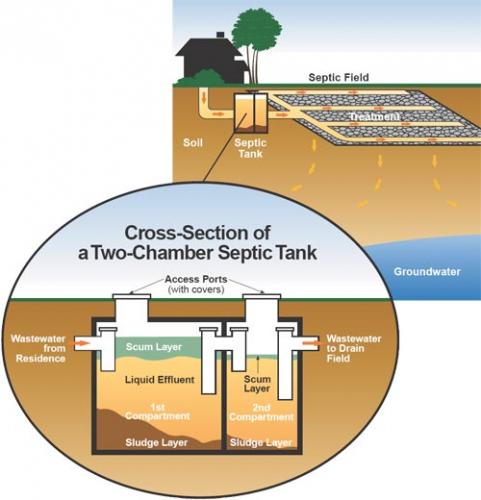

Certified Master Inspector
Providing Residential and Commercial Property Inspections for Muskoka
8 a.m. to 7 p.m., 7 Days a Week
Call 705 205 4663
DoneRight1@live.ca
8 a.m. to 7 p.m., 7 Days a Week
Call 705 205 4663
DoneRight1@live.ca


 Septic systems found in Muskoka homes, cottages, and commercial properties treat and disperse relatively small volumes of wastewater. Septic system regulation is usually a Provincial and local responsibility. CMHC and The EPA provides information to homeowners and assistance to Provincial and local governments to improve the management of septic systems to prevent failures that could harm human health and water quality.
Septic systems found in Muskoka homes, cottages, and commercial properties treat and disperse relatively small volumes of wastewater. Septic system regulation is usually a Provincial and local responsibility. CMHC and The EPA provides information to homeowners and assistance to Provincial and local governments to improve the management of septic systems to prevent failures that could harm human health and water quality. Have your home, cottage, or commercial septic system inspected at least every three years. Hire an InterNACHI inspector trained in septic inspections. No one wants to see this stuff coming back into the home!

Pump your septic tank as needed (generally, every three to five years).
Don't dispose of household hazardous waste in sinks or toilets.
Keep other household items, such as dental floss, feminine hygiene products, condoms, diapers, and cat litter out of your system.
Only plant grass or low ground cover over and near your home, cottage, or commercial septic system. Roots from nearby trees or shrubs might clog and damage the system. Also, do not apply manure or fertilizers over the drain field.
Keep vehicles and livestock off your septic system. The weight can damage the pipes and tank, and your system may not drain properly under compacted soil.
Keep gutters and basement sump pumps from draining into or near your septic system. Flooding the drainfield with excessive water slows down or stops treatment processes and can cause plumbing fixtures to back up.
Check with your local health department before using additives. Commercial septic tank additives do not eliminate the need for periodic pumping and can be harmful to your system.
Did you know that, as a home, cottage, or commercial property owner, you are responsible for maintaining your septic system? Did you know that maintaining your septic system protects your investment in your property? A key reason to maintain your septic system is to save money! Failing septic systems are expensive to repair or replace, and poor maintenance is often the culprit. Having your septic system inspected (at least every 3 years) is a bargain when you consider the cost of replacing the entire system.
The forgoing Information courtesy of www.nachi.org
Septic system Inspections
Full septic system inspections are outside the scope of general home inspections and normally conducted by septic system installers when there is an obvious problem such as effluent blowout on the surface. By this time of course, it usually means its too late. If regular yearly maintenance and a functioning inspection every three years haven't been done, you may be buying a new 15-20 thousand dollar system.
A full septic inspection includes not just a pump out but a full interior tank clean-out (usually a steam cleaning) and interior inspection. Any suspicion of cracking means the the tank may have to be dug around to expose the exterior to check for cracks and or leaks. The inspector is looking to see if the tank is intact, or are there signs of deterioration,or cracking.They are trying to determine if the tank itself can it be salvaged.
A full Septic inspection will also include both a functional line flow test and a soil percolation test. Both tests require digging and disturbing parts of bed area. Are all the effluent lines clear and flowing? Or, are they plugged with roots or other matter? Is the surrounding soil able to dissipate the effluent or is it saturated and unable to handle any more loading? An electrical draw test on the pump if the system is equipped with a pump tank and digging around the pump tank to check for leaks is included as part of a full system inspection.
Of course, depending on the nature of the problem the inspector was called for, any one of these tests may be unnecessary for obvious reasons. These tests are fully invasive and require special training and equipment.
Functional Septic Inspections

I answer the question; is the system currently working properly from water/waste source inside the home through the home waste plumbing to the tank and through that system to the distribution outlet in the tank? Are the distribution lines accepting wastewater at a reasonable rate of flow? I also answer the question where are the system components located?
Barring visual evidence to the contrary (water ponding on the bed surface or blowout at the bed edges for example) if the system is being used and if effluent is flowing at the tank distribution outlet, and if the wastewater leaves the tank without the level in the tank changing when a heavy flow is induced, for the purpose of a functional septic inspection it is assumed the lines underground are flowing and the soil is not saturated.
I may gather information before the inspection from the Owner, and the Health and Building Departments if required.
On the day of Inspection; I will inspect and evaluate the plumbing system of the house, in specific looking for leaking fixtures and equipment. Even small leaks that do no harm inside the home, like those in an overflow in the toilet tank, can have effects that lead to overloading the septic system over a relativity short time.
I will physically locate the major components of the system. Locate and access, (This is just one of those dirty jobs that somebody has to do) the treatment tank, cesspool or seepage pit, measure the sludge depth and mat thickness if present. Locate the effluent delivery and distribution section locate the absorption area, and any risers, filters and baffles possible. If necessary due to a concealed location, using three points of reference I will then draw out a location map of the system and the outer limits of its components to include in my report.
I also perform a routine maintenance inspection using visual-only, non-invasive inspection techniques; after which I give a written report to my client.
The report includes:
The rough location of the systems components;
The apparent condition of all visible components
A functional test of the system from water source to effluent tank outlet.
To assist in determining condition I will measure, evaluate and report on both sludge depth and mat thickness. The report will explain how the system works, and give maintenance recommendations.
A typical functional septic inspection is:
An objective evaluation of the on site wastewater treatment system based upon the inspectors experience and knowledge;
An evaluation of each inspected component of the system; and a conclusion about the systems condition.
A typical functional septic inspection is NOT:
A warranty or guarantee that the system will properly function for any period of time in the future; and / or a certification of the systems installation or performance.
( Note 1) Please do not ask for a vendor pumpout prior to the septic inspection as without the sludge depth, mat thickness, and effluent flow traits, you cannot draw valid conclusions as to functionality.
( note 2 ) I do not recommend a functional septic system inspection if the residence has been vacant and the system has been unused for periods longer than 9 months. Its a crapshoot. You cannot tell if the tank effluent is low because the tank is leaking or it has evaporated. It may have dissipated through the concrete on concrete tanks. You may not be able to get an accurate measurement of mat and sludge thickness. You will have no or little flow in the distribution lines so you cannot assume they are in functional condition. They may not be.
In my case I learned this one the hard way.
20 years ago about three months after buying my home which had been vacant for about nine months prior, the system backed up. I had to dig out all the lines because chipmunks had enlarged the weeping holes in the dry pipes and stuffed their 'tunnels" full of acorns the fall before from the five large oak trees I have nearby. I'm not sure who was madder the chippies for loosing their stashes or me for having to dig it all up and replace all the pipe they made big holes in.
Done Right Home Inspections 705 205 4663 any time